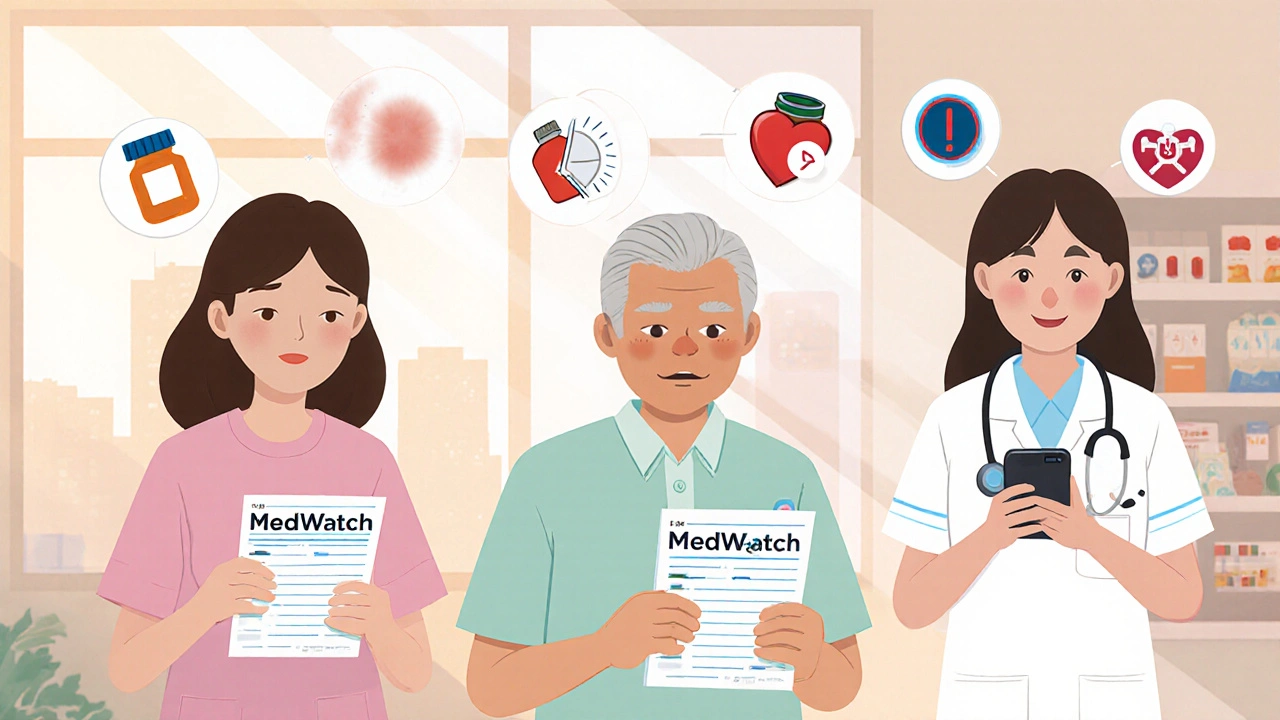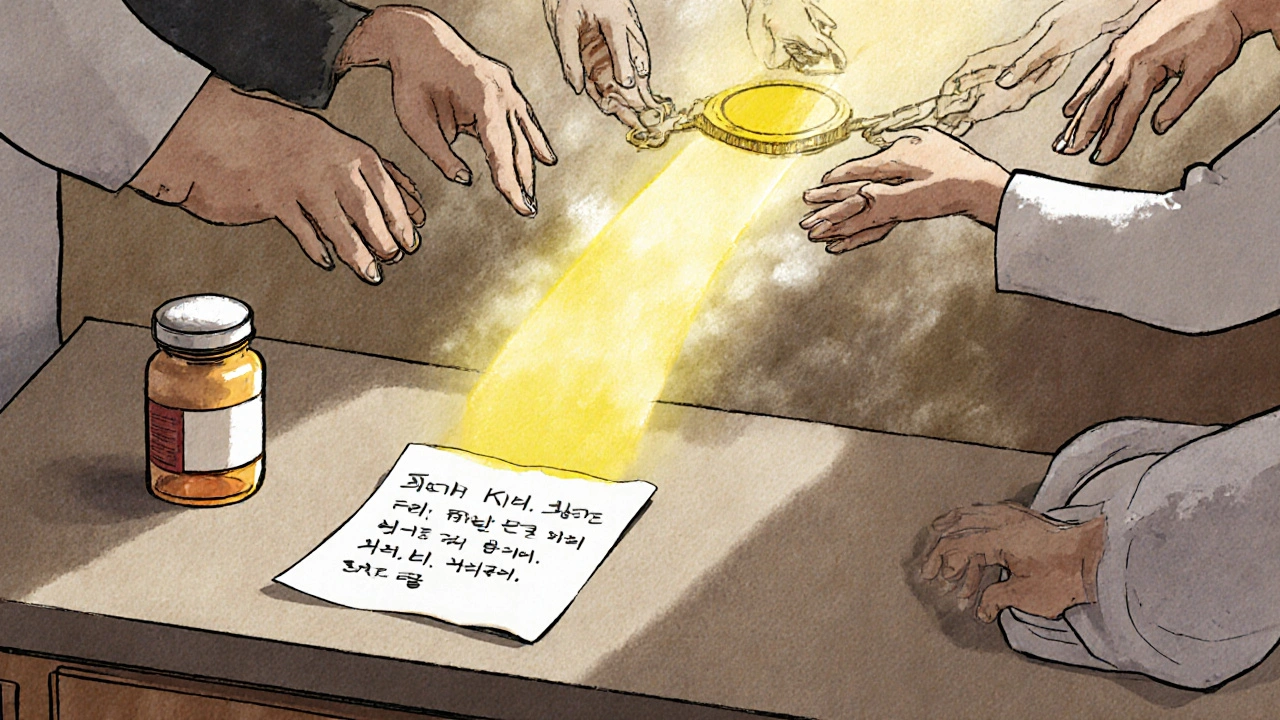MedWatch: How to Report Medication Side Effects and Safety Issues

Every year, millions of people take prescription drugs, over-the-counter medicines, and dietary supplements without a second thought. But what happens when something goes wrong? A strange rash. A sudden drop in blood pressure. A child having a seizure after a new vaccine. These aren’t rare outliers-they’re signals. And MedWatch is the system designed to catch them.
MedWatch isn’t a hospital or a clinic. It’s not even a physical place. It’s the U.S. Food and Drug Administration’s (FDA) official way for anyone-doctors, nurses, pharmacists, patients, and even family members-to report serious problems with medicines, medical devices, vaccines, and other regulated products. The system started in 1993, but its purpose hasn’t changed: to find hidden dangers that didn’t show up during clinical trials.
What Exactly Can You Report to MedWatch?
You don’t need to be a medical expert to report. If something bad happened after using a product, and you think it might be linked, report it. The FDA doesn’t expect you to prove causation-they just need the facts.
Here’s what counts:
- Severe allergic reactions (anaphylaxis, swelling, trouble breathing)
- Hospitalization or emergency room visits caused by a drug or device
- Birth defects linked to medication use during pregnancy
- Loss of vision, hearing, or mobility after taking a drug
- Device failures (like a pacemaker stopping or an insulin pump malfunctioning)
- Contaminated or mislabeled products (e.g., pills with the wrong dose, fake supplements)
- Therapeutic failures (a drug that completely stops working when it should)
Even if you’re not sure, report it. The FDA’s analysts look for patterns. One report might mean nothing. Ten reports about the same drug causing the same rare side effect? That’s a red flag.
Who Can Report-and Which Form Do You Use?
MedWatch has three reporting paths, depending on who you are.
Healthcare professionals (doctors, nurses, pharmacists) use Form FDA 3500. This is the most detailed version. It asks for patient age, gender, medical history, exact drug name and dose, timing of the reaction, lab results, and outcome. It’s meant for people who have access to full medical records.
Patients and consumers use Form FDA 3500B. This version is simpler. It asks for the product name, what happened, when it happened, and your contact info. You don’t need to know medical terms. Just describe what you saw. The form is available in Spanish since 2022, making it accessible to millions more.
Manufacturers and distributors must report under federal law. They use Form FDA 3500A and are required to submit serious events within 15 days. Non-serious ones have a 90-day window. This mandatory reporting is what fills the majority of MedWatch’s database.
There’s no cost to file. You can submit online, by mail, or by fax. The online portal at fda.gov/MedWatch walks you through each step. Most people finish in 15 to 20 minutes.
Why Most People Never Report-And Why You Should
Here’s the hard truth: fewer than 1 in 10 serious side effects ever make it into MedWatch. A 2022 Government Accountability Office report found that consumers report only 1% to 10% of serious events. Why?
- Most people don’t know MedWatch exists.
- They think it’s the doctor’s job.
- They’re afraid they’ll be blamed.
- They get no feedback after submitting.
But here’s what happens when people do report:
In 2007, reports of heart attacks in people taking the diabetes drug rosiglitazone led to new warnings and restricted use. In 2018, a spike in reports of severe skin reactions from a common acne medication resulted in a boxed warning-the strongest type the FDA can issue. In 2021, a pattern of liver damage linked to a popular herbal supplement triggered a public alert and eventual removal from shelves.
These weren’t lab studies. They weren’t clinical trials. They were real people, using real products, reporting real problems. Without MedWatch, those dangers might have gone unnoticed for years.

What Happens After You Submit?
You won’t get a phone call. You won’t get a case number. That’s frustrating-and it’s by design.
The FDA doesn’t respond to individual reports because they’re not meant to be medical advice. They’re data points. A single report doesn’t trigger action. But when 50 people report the same issue with the same drug? That’s when analysts dig in. They cross-check with hospital records, lab data, and other global systems like Europe’s EudraVigilance.
From 2021 alone, MedWatch data helped the FDA:
- Update 18 drug labels with new safety warnings
- Issue 7 public safety alerts
- Remove 3 products from the market
These aren’t theoretical numbers. Each one represents a real risk avoided for future patients.
Still, the system has flaws. About 30% of reports are incomplete or contain unclear descriptions. Some people mix up brand and generic names. Others forget to include the date the reaction started. The FDA is trying to fix this with AI tools that now help sort reports faster and flag high-risk cases. By 2026, they plan to require standardized medical terms (like SNOMED CT) to make data easier to analyze.
How to Make Your Report Count
If you’re reporting, don’t just fill out the form-make it useful.
- Be specific: Instead of “I felt sick,” write “Within 48 hours of taking ibuprofen, I developed severe vomiting and dizziness that lasted 3 days.”
- Include dates: When did you start the drug? When did the problem begin? When did it end?
- Write down everything: Even if it seems minor. A headache that started the same day as a new blood pressure pill? Include it.
- Use the generic name: “Metformin” is better than “Glucophage.”
- Don’t wait: Report as soon as you can. Memories fade. Records get lost.
And if you’re a healthcare provider: don’t assume someone else will report it. If you see a reaction, even if it’s rare, file the form. Your report might be the one that saves a life.

What MedWatch Can’t Do
It’s important to know the limits.
MedWatch won’t:
- Give you medical advice
- Replace your doctor
- Provide compensation or legal help
- Immediately pull a drug off the market
It’s a surveillance tool, not a response team. The FDA uses the data to decide whether to issue warnings, change labels, or investigate further. That process can take months-or years.
That’s why the FDA is building stronger systems alongside MedWatch. The Sentinel Initiative now monitors electronic health records from over 300 million patients in real time. It’s like having a national health monitor watching for patterns. But even Sentinel needs MedWatch. Because not everyone goes to a hospital. Not everyone has an EHR. And not every side effect shows up in a chart.
What’s Next for MedWatch?
By 2025, the FDA plans to let certified health apps and electronic health record systems send reports directly to MedWatch-no form filling needed. Imagine your EHR auto-filing a report if a patient develops a known serious side effect. That’s the future.
Right now, the system still relies on people. Real people. Patients. Parents. Nurses. Pharmacists. If you’ve ever wondered whether your voice matters in drug safety-yes, it does.
One report might not change the world. But 10,000? That’s how safety improves.
Can I report a side effect if I’m not a doctor?
Yes. Anyone can report. Patients, family members, caregivers, and consumers use Form FDA 3500B, which is designed to be simple and doesn’t require medical knowledge. You just need to describe what happened, when, and with what product.
How long does it take to file a MedWatch report?
Most people complete the online form in 15 to 20 minutes. The consumer version (3500B) is shorter and easier than the professional version (3500). You can also report by phone at 1-800-FDA-1088 or by mail using downloadable forms.
Will the FDA contact me after I report?
No, the FDA does not respond to individual reports. MedWatch is a passive surveillance system-it collects data, not feedback. Your report becomes part of a larger database used to detect patterns. If your report helps identify a safety issue, you won’t be notified, but others may benefit from the action taken.
What if I’m not sure if the side effect is related to the drug?
Report it anyway. The FDA doesn’t expect you to prove causation. They’re looking for signals. If multiple people report similar reactions after using the same product, analysts investigate further. Uncertainty is normal-your report could be the first clue.
Are dietary supplements covered by MedWatch?
Yes. All FDA-regulated products are covered, including dietary supplements, vitamins, herbal products, and homeopathic remedies. If you have a serious reaction to a supplement, report it. Many supplement-related problems go unreported because people assume they’re “natural” and therefore safe.
Is MedWatch only for U.S. residents?
Yes. MedWatch is a U.S. program run by the FDA. If you live outside the U.S., you should report to your country’s national pharmacovigilance system. However, if a product you used was sold in the U.S. (even if you bought it overseas), you can still report it to MedWatch.
